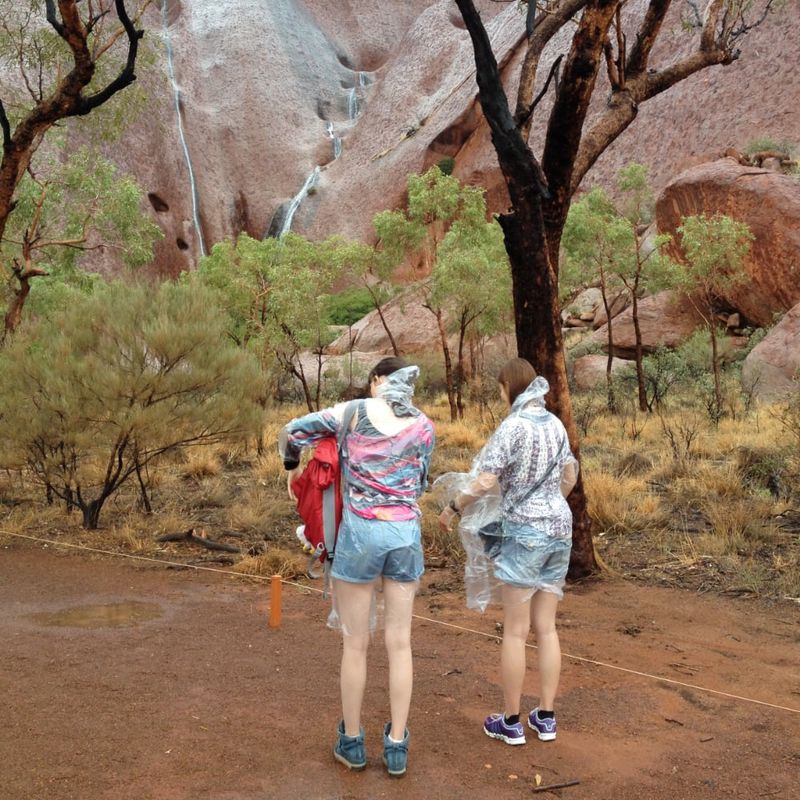Rain on the rock
Many visitors enjoy Uluṟu and Kata Tjuṯa’s rich reds and bright oranges at sunrise and sunset. But only a few are lucky enough to experience the magical colours and waterfalls that occur after heavy rain.
As the temperature drops and a moody Uluṟu emerges from the fog, the arid desert explodes with colour and life.
Rainwater on the rock’s surface causes it to change colour. From dark burgundy to shining silver and even black, every side of Uluṟu takes a different shade, making this spectacle a photographer’s delight. Meanwhile, desert plants bloom in the gushing water and many animals emerge to mate and feed.
Rain and life in the desert
Rain is vital to the plants and animals of the Central Desert. Heavy rain recharges the arid ecosystems and underground waterways, triggering a massive pulse of life.
Because rainfall in the region is so erratic, animals and plants have evolved ways of conserving water by avoiding, tolerating or controlling extremes of heat. Desert animals rely on opportunistic breeding and feeding, and rains bring a frenzy of activity to replenish and reproduce.
The first rainfalls produce some strange sights. Birds shower in the rain and some (like galahs) splash and play, swinging by their beaks and hanging upside-down. Animals usually only seen at night often emerge from hiding to drink and savour the occasion.
During heavy rain, water filters down through the sand and wakes burrowing frogs from hibernation. These frogs bury themselves deep beneath the hot and dry surface for years until the rain signals it’s time to emerge and mate.
Life stirs in the clay-pans and rock-holes too. The touch of water triggers the development of eggs that have been lying dormant for years. Within days, waterholes and pools around the park are swarming with tiny shield shrimp.
Rain also stimulates insects to hatch and breed, including mosquitoes, termites, beetles and centipedes. This abundance of food brings out birds and reptiles, who find their way along the floodwater, streams and rivers looking for a feast.
Visitors may be able to spot larger mammals such as kangaroos, wallabies and dingoes, which are seldom seen at other times. Even the shy and secretive itjaritjari (marsupial mole) occasionally comes out after rain.
The rain also promotes plant growth. Trees around the waterholes turn lush and green, and grasses and native fuchsias grow . Meanwhile, tjulpun-tjulpunpa (wildflowers) cover the ground in a sea of colour.
When does it rain at Uluṟu?
The weather in Uluṟu-Kata Tjuṯa National Park is extreme, highly variable and very difficult to predict. The average annual rainfall is around 300 mm, but this varies a lot from year to year.
While rain can fall at any time, heavy rains are most likely between November and March (although very heavy downpours have also occurred in May). Lightning storms are most common from October to February and are often preceded by strong, dry winds.
The daily weather forecast is available at the Cultural Centre.
Find out more about our seasons or when to come.
How to prepare for the rain

If you are lucky enough to experience heavy rain at Uluṟu, you’ll need to make sure you’re well prepared before heading out.
Here are a few tips:
- Bring rain protection. Many tour operators provide umbrellas and ponchos, or you may be able to purchase rain gear in the Yulara town centre.
- You should also bring a sweater or jacket, as the temperature can drop dramatically during heavy rains.
- Wear sturdy, closed-toe shoes. The tracks around Uluṟu can get very muddy when wet, and insects and reptiles (including snakes and centipedes) may come out after the rain.
- Don’t forget your camera – rain on the rock provides plenty of opportunities for amazing photographs!
Waterfalls appear all over Uluṟu during heavy rain, and many can be seen from the comfort of a dry vehicle. But two of the easiest (and most impressive) places to experience waterfalls up close are the Kuniya walk to Mutijulu Waterhole and the Mala walk to Kaṉtju Gorge.
Uluṟu’s semi-permanent waterholes – Kaṉtju Gorge and Muṯitjulu Waterhole – boast raging waterfalls during heavy rain, while skinny streams of water are visible all over the rock as you walk towards these two attractions.
You’ll probably hear lots of frogs near these waterholes as well. Listen closely for the loud mating calls of trilling frogs, the ‘baa-baa’ of sheep frogs and the unusual sounds of shoemaker frogs, who make a noise like hundreds of people hammering nails into wood.

